
Behavior is the result of motor activities which range from a simple muscular twitch tc, the creation of a work of art. If we consider the skill involved in nest building, the strategies of fighting animals, or the precision of piano playing, it is obvious that these activities are not solely the result of physical and chemical processes of muscular contraction but depend on conscious direction-on the refined complexity of their cerebral command.
Very little is known about the automatic aspects of voluntary acts, how purpose is related to performance, or how contractions are organized in time and space. Present methodology, however, has placed some of these questions within experimental reach. The fact that ESB can induce simple movements was discovered in the nineteenth century, and today we know that the cerebral organization of motility is located mainly in the cortex of the parietal lobe. Stimulation of this area induces movements on the opposite side of the body, while its destruction results in paralysis. These findings have been expressed in attractive diagrams showing the motor areas of the brain as an "homunculus" lying upside down in the parietal cortex, with a big face and a big thumb, like a caricature of a little man in charge of motility. This image was partly responsible for consideration of the cortex as the supreme and intelligent organizer of behavior.
However, further research demonstrated that motor responses obtained from this cortex are rather crude and that other areas
Page 100
in the depth of the brain have a decisive role in the organization of skilled motility. Modern concepts suggest that the cortex should not be considered the highest hierarchical structure of the motor system or even the starting point of motor impulses, but rather a way station, one more link in the loops of sensorymotor correlations. The multiplicity and complexity of motor representation is logical when we consider the tremendous variety of behavioral manifestations which constitute the only means of communication between the individual and his surroundings. This relation requires a motor performance with precise temporal and spatial coordination among many functional units and the processing of a great deal of information for the adjustment and guidance of movements and for instantaneotis adaptation to changes in circumstances. Because of the complexity of these mechanisms, it has been assumed that the artificial ESB could never induce refined and purposeful motor performance. The surprising fact is that, depending on its location, electrical stimulation of the brain is able to evoke not only simple responses but also complex and well-organized behavior which may be indistinguishable from spontaneous activity.
Motor Activation in Animals
A classical experiment for medical students is to anesthetize a rabbit or other small mammal and to expose its brain in order to stimulate the motor cortex. In this way simple responses, such as contraction or extension of the limbs, may be demonstrated. These responses usually involve a small group of muscles, are stereotyped, and lack adaptability, but in spite of these limitations students are generally impressed by seeing the movements of an animal placed under the command of a human being. The demonstration is far more elegant if the experimental animal is completely awake and equipped with electrodes implanted in the brain. Then the responses appear more physiological, and we can investigate the mutual influence of spontaneous and evoked motility.
Page 101


Page 102

Electrical Stimulation of the right-side motor cortex of a cat may produce flexion of the left hind leg with an amplitude of movement proportional to the applied intensity. For example, in one experiment when the animal was standing on all fours, the intensity of 1.2 milliamperes evoked flexion of the leg barely off the ground. At 1.5 milliamperes, the hind leg rose about 4 centimeters, and when 1 .8 milliamperes were applied, leg flexion was complete (Figure 8). The evoked movement began slowly, developed smoothly, reached its peak in about two seconds, and lasted until the end of the stimulation. This motor performance could be repeated as many times as desired, and it was accompanied by a postural adjustment of the whole body which included lowering of the head, raising of the pelvis, and a slight weight shift to the left in order to maintain equilibrium on only three legs, The electrical stimulation did not produce any emotional disturbance, and the cat was as alert and friendly as usual, rubbing its head against the experimenter, seeking to be petted, and purring.
Page 103
If, however, we tried to prevent the evoked effect by holding the left hind leg with our hands, the cat stopped purring, struggled to get free, and shook its leg. Apparently the evoked motility was not unpleasant, but attempts to prevent it were disturbing for the animal, suggesting that stimulation produced not a blind motor movement but also a desire to move, and the cat cooperated spontaneously with the electrical command, adjusting its posture before performing the leg flexion. It was evident that the animal was not in a hurry and took its time in preparing for the induced movement. Preliminary adjustments were not seen if the cat's posture was already adequate for the leg flexion. In cases of conflict between the spontaneous movements of the animal and those elicited by the experimenter, the final result depended on the relative strength of the opposing signals. For example, if the cat was walking, threshold stimulations of i.2 milliamperes for slight leg flexion were ineffective. If the cat was stimulated while jumping off a table to reach food, stronger intensities of up to 1.5 milliamperes, which usually evoked a clear motor response, were also ineffective; physiological activity seemed to override the artificial excitation and the cat landed with perfectly coordinated movements. If the intensity was increased to 2 milliamperes, stimulation effects were prepotent over voluntary activities; leg flexion started during the jump, coordination was disrupted, and the cat landed badly. A similar experiment is described on page 186.
In monkeys, electrical stimulation of motor areas has evoked contralateral movements similar to those described for the cat. The stimulated animal showed no signs of fear or hostility (Figure 9), nor did he interrupt his spontaneous behavior, such as walking, climbing, or eating. Evoked and spontaneous movements influenced each other, and the final response was a combination of both.
Simultaneous stimulation of two cerebral points with opposite effects could establish a dynamic balance without any visible effect. For example, if excitation of one point produced turning of the head to the right and another one produced turning to the
Page 104

left, the monkey did not move his head at all when both points were stimulated. This equilibrium could be maintained at different intensity levels of simultaneous stimulation.
Brain stimulation of different areas has elicited most of the simple movements observed in spontaneous behavior, including frowning, opening and closing the eyes, opening, closing, and deviation of the mouth, movements of the tongue, chewing, contraction of the face, movements of the cars, turns, twists, flexions, and extensions of the head and body, and movements of the arms, legs, and fingers. We must conclude that most if not all of the possible simple movements can be evoked by electrical stimulation of the brain, Abnormal responses, disorganized
Page 105
Movements, loss of equilibrium (as shown in Figure 10), and epileptiform convulsions have also been produced, depending on the cerebral area and parameters of stimulation investigated.
Turning now to more complex responses, we must realize that normal activities in animals and man involve a succession of different acts well coordinated in space and in time. Walking, for example, is a displacement of the body with alternate flexion and extension of the extremities requiring refined control of strength, amplitude, and speed for the contraction of different groups of muscles with precise timing and mutual correlation aimed toward a common goal. In addition, postural adaptation and corrective movements of the head and body are necessary. To induce walking in an animal by programed electrical stimulation of individual muscles would be a formidable task requiring the wiring of perhaps too muscles, the use of a complex cornputer, sophisticated timing mechanisms, large numbers of stimulators with instantaneously adjustable intensities, many sensors, and the help of a team of scientists and technicians, in addition to a cooperative animal and a measure of good luck. The surprising fact is that electrical pulses applied directly to the brain activate cerebral structures which possess the necessary functional complexity to induce walking with apparently normal characteristics.
In one of our experiments, monkey Korn was sitting in the colony cage picking some food when radio stimulation of his thalamus, located in the center of the brain, began. The animal slowly got up and started walking around the cage on all fours at a speed of about 1 meter per second, without bumping against the walls or against other animals, in a normal manner without any signs of anxiety, fear, or discomfort. At the end of 5 to 10 seconds of stimulation, the monkey calmly sat down and resumed picking food. As soon as stimulation was reapplied, Kuru re-sumed walking around the cage. In some studies this effect was repeated as often as sixty times in one hour.
The speed and pattern of a motor response vary according to the cerebral structure stimulated. The effect most often observed
Page 106
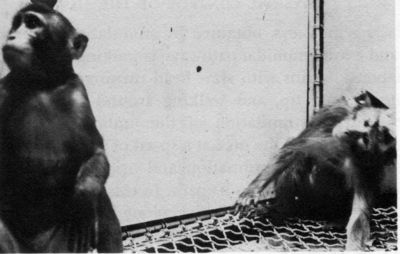
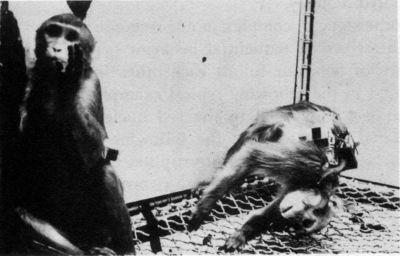
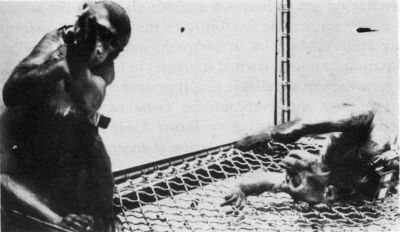
Page 107
in cats and monkeys, obtained by stimulation of limbic structures and extrapyramidal pathways, is walking in circles. Usually the response begins with slow head turning, followed by body turning, getting up, and walking around the cage. In other studies, during stimulation of the fimbria of the fornix, a monkey ran around the cage at a speed of 2.4 meters per second, showing excellent coordination and orientation, avoiding obstacles or other animals in its path. In this experiment, as shown in Figure 11, one monkey in the colony learned to press a lever in the cage which triggered radio stimulation of the test animal. Repetition of these excitations produced conditioning in the stimulated monkey.
Another type of complex motor response induced by ESB has been described as sequential behavior (54) in which different patterns of behavior follow each other in a precise order, as indicated in the following typical example. Monkey Ludy had one contact implanted in the red nucleus, and when it was stimulated for 5 seconds, the following effects appeared (see Figure 12): (1) immediate interruption of spontaneous activity; 2) change in facial expression; (3) turning of the head to the right; (4) standing on two feet; (5) circling to the right; (6) walking on two feet with perfect balance, using both arms to maintain equilibrium during bipedestation; (7) climbing a pole; (8) descending to the floor; (9) uttering a growl; (10) threatening and often attacking and biting a subordinate monkey; (11) changing aggressive attitude and approaching the rest of the group in a friendly manner; (12) resuming peaceful spontaneous behavior. This complex sequence of events took place during ten to fourteen seconds always in the same order but with considerable flexibility in the details of performance. Ludy avoided obstacles in her path, walked with excellent coordination, and used normal strategies in her fights. The sequential response was so reliable that it persisted after 2o,ooo stimulations repeated once every minute. Demonstrating the specificity of evoked effects, Figure 13 shows Ludy's very different response evoked by radio stimulation of another red nucleus point located three millimeters away.
Page 108
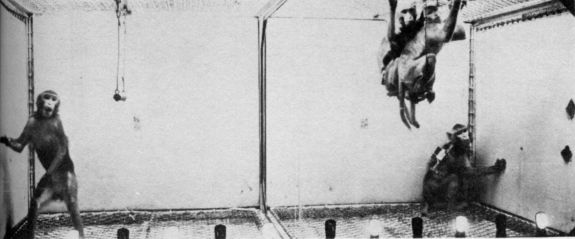
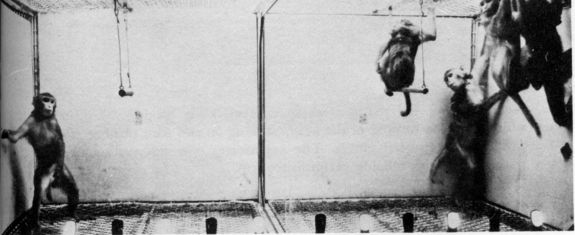
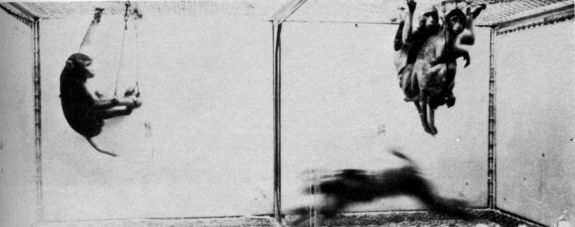
Page 109

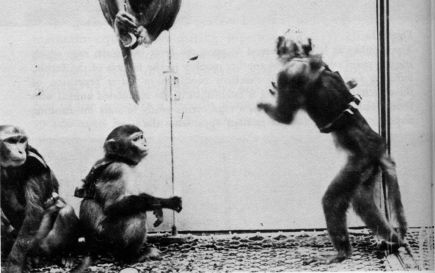
Page 110
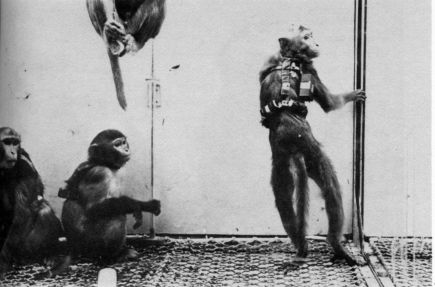
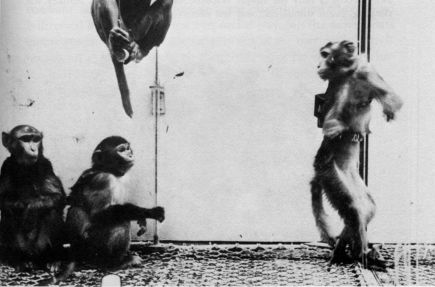
Page 111
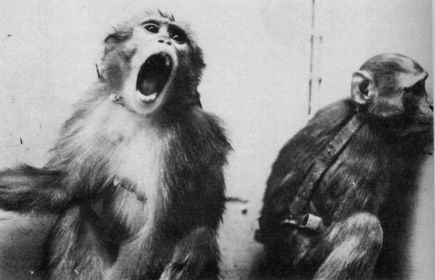
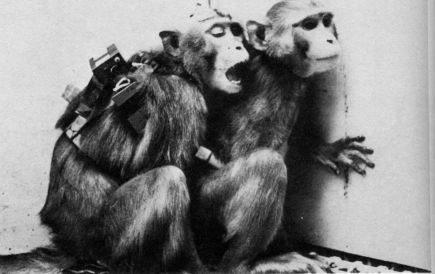
Page 112
Many questions were aroused by these experiments. Why was Ludy walking on two feet? Why the chain of behavioral events? Why was she aggressive a few seconds after the end of stimulation? More studies are needed in order to understand these problems, but the fact that similar sequences have been evoked in other monkeys indicates that we are dealing with rather specific mechanisms of intracerebral organization.
When reviewing tire motor responses that can be induced by electrical stimulation several important limitations should be considered: (i) Lack of predictability: When a point of the brain is stimulated for the first time, we cannot predict the effects which may be evoked. When the upper part of the motor cortex is stimulated, it is highly probable that the contralateral hindlimb will contract, but we cannot foresee the quality of this movement or the participation of other body muscles, or know whether this response will affect the whole leg or only the foot. Once the evoked effect is known, repeated stimulations gives predictable results provided that the experimental situation is constant. (2) Lack of purpose: In some cases the evoked response is directed by the animal in a purposeful way, but the movements and sequential responses are usually out of context, and there is no reason or purpose for yawning, flexing a hand, or walking around, apart from ESB. It is important to differentiate these aimless motor responses from other types of behavior described later in which the aim is of primary importance an t e motor performance secondary. (3) No robot performance: Brain stimulation activates cerebral mechanisms which are organized for motor performance, but it cannot replace them. With the present state of the art, it is very unlikely that we could electrically direct an animal to carry out predetermined activities such as opening a gate or performing an instrumental response. We can induce pleasure or punishment and therefore the motivation to press a lever, but we cannot control the sequence of movements necessary for this act in the absence of the animal's own desire to do so. As will be discussed later, we can evoke emotional states which may motivate an animal to attack another
Page 113
or to escape, but we cannot electrically synthesize the complex motor performance of these acts.
Motor Effects in Man
The most common effect obtained by electrical stimulation of the human brain is a simple motor response such as the contraction of an extremity. This effect is often accompanied by lack of voluntary control of the muscles involved, and occasionally it is limited to a local paralysis without any other observable symptoms. In general, the evoked contractions are simple in performance, artificial in character, lacking purpose, and without the elegance of spontaneous motility. For example, in one of our patients, stimulation of the left parietal cortex through implanted electrodes evoked a flexion of the right hand starting with contraction of the first two fingers and continuing with flexion of the other fingers. The closed fist was then maintained for the rest of the 5-second stimulation. This effect was not unpleasant or disturbing, and it developed without interrupting ongoing, behavior or spontaneous conversation. The patient was aware that his hand had moved involuntarily but he was not afraid and only under questioning did he comment that his arm felt "weak and dizzy." When the patient was warned of the oncoming stimulation and was asked to try to keep his fingers extended, he could not prevent the evoked movement and commented, "I guess, Doctor, that your electricity is stronger than my will." If this stimulation was applied while the subject was voluntarily using his hand, for instance to turn the pages of a magazine, this action was not blocked but the induced hand flexion distorted voluntary performance and resulted in crumpling and tearing of pages. In our experience and in reports by other investigators, electrical stimulation of the motor cortex has not induced precise or skillful movements, and in all cases the evoked responses have been clumsy and abnormal.
Excitation of the supplementary motor area, located near the main motor cortex, may induce three types of effects (174): (1)
Page 114
There can be postural changes, in which the movement starts slowly and attains a determined end point with more or less general involvement of the body. (2) The movements can have a phasic character such as pawing with the hand, stepping with the foot, or flexing and extending the fingers or wrist. (3) The response can consist of uncoordinated movements. Of special interest is the possibility of activating paralyzed limbs by means of ESB. For example, one patient was suffering from sudden paralysis of the left arm and leg probably caused by an embolus, and after four years he had begun to experience burning pain in the left side of his body which was exacerbated by touching his left thorax or arm. After other treatments failed, two surgical interventions were performed to ablate parts of the sensorimotor cortex, and it was observed that electrical stimulation in the supplementary motor area produced vocalization, raising of the paralyzed arm, and other motor responses. These effects were similar to those evoked in other patients without paralysis. Thus it is clear that the supplementary cortex has pathways independent from the classical motor pathways and that evoked movements may be independent from the integrity of the main motor representation in the cortex.
ESB apparently produces similar results whether applied to the motor area of a child or an adult, of a manual laborer or of an accomplished artist. Skills and refined movements not stem to be represented in the cortex, or at least they have not been aroused by its electrical stimulation. The motor cortex is probably like a large keyboard located on the efferent side, dealing with the output of activity, able to play the strings of muscular contraction and to produce movements, but requiring the direction of other cerebral structures which as yet are little known.
In contrast to these effects, ESB may evoke more elaborate responses. For example, in one of our patients, electrical stimulation of the rostral part of the internal capsule produced head turning and slow displacement of the body to either side with a well-oriented and apparently normal sequence, as if the patient
Page 115
were looking for something. This stimulation was repeated six times on two different days with comparable results. The interesting fact was that the patient considered the evoked activity spontaneous and always offered a reasonable explanation for it. When asked "What are you doing?" the answers were, "I am looking for my slippers," "I heard a noise," "I am restless," and "I was looking under the bed." In this case it was difficult to ascertain whether the stimulation had evoked a movement which the patient tried to justify, or if an hallucination had been elicited which subsequently induced the patient to move and to explore the surroundings.
There are very few clinical reports of complex movements evoked by ESB which are comparable to the sequential responses observed in monkeys, and this may indicate that cerebral organization is less stereotyped in man than in animals. Temporal lobe stimulation in man has induced automatisms, including fumbling with surgical drapes or with the patient's own hands, and well-organized movements aimed at getting off the operating table. Usually these evoked automatisms have not been remembered. Vocalizations and more or less intelligible speech may also be included among complex motor responses, although) they represent the activation of motor and ideational mechanisms. Vocalizations have been obtained by stimulation of the motor area in the precentral gyros and also of the supplementary motor area in both hemispheres. The response usually consists of a sustained or interrupted cry with a vowel sound which occasionally has a consonant component (174).
Page 116